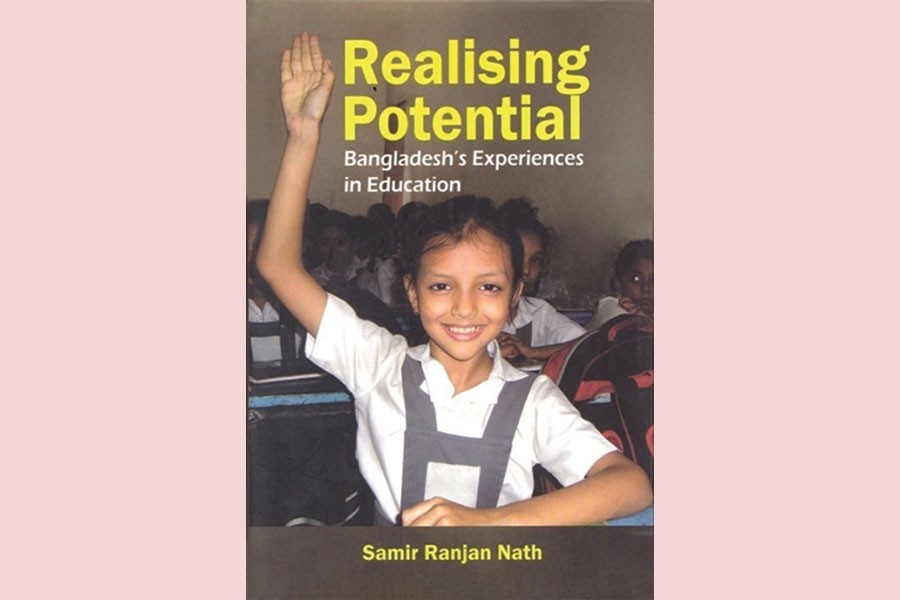The education system that we see in today's Bangladesh is basically inherited from British-India. Expansion of education among the mass people started during that period. However, Bangladesh's independence of 1971 opened the door for the country to adopting development strategies in all sectors of human life, including education sector development. The country has undoubtedly made remarkable progress in the field of education over the last few decades. The government policies regarding development of this particular sector, community initiatives, and involvement of the non-government organisations (NGOs) collectively, made this possible. Yet, a lot remains unfinished. Expansion of education in some areas, combating corruption in the education sector, assurance of quality and parity, and removal of discrimination at all levels of education are the big challenges of our education system. Samir Ranjan Nath's book 'Realising Potential: Bangladesh's Experiences in Education' is an attempt to look back at the journey of Bangladesh in the field of education during the period of 1971 - 2015. The author minutely examines the policies and plans in the education sector and identifies disparities as well as areas for improvement in this crucial sector.
The book contains three articles. The first one is the principal piece, which reflects on the overall country status and the way forward. It examines the national-level policies, plans and programmes undertaken for the development of all streams and sub-sectors of education (i.e. primary, secondary, college, madrasa, technical & vocational, and university) during the first four-and-a-half decades of Bangladesh, and highlights progresses made in these sectors. It is no doubt that a significant improvement in access to all levels of education has occurred during the last 45 years. The increase in the number of educational institutions as well as the participation of girls in all levels of education is a great achievement. However, progress in the quality of education is not satisfactory. A recent study conducted by 'Education Watch' indicates that our primary education system has become exam-centric rather than child-centric. Many independent studies have also raised questions about the quality of teaching-learning activities at both primary and secondary levels.
Our universities are under pressure to fulfil the increased demand of tertiary education. But this sub-sector, the author observes, faces two major challenges: i) Lack of seats to accommodate all interested graduates, and ii) Inability to provide research and other facilities to students already admitted to universities. Tertiary education can play a vital role in sustainable human resource development as well as in various aspects of further development of education, including teacher training, curriculum planning and assessment. It is therefore important, the author recommends, emphasis be laid on capacity building of university education in Bangladesh through collaboration of the country's universities with the universities of developed countries.
The second article "BRAC's Non-formal Approach to Primary Education" is a case study which explores the country's largest non-formal approach to primary education. It analyses the quality of the BRAC intervention in pre-primary and primary education, gathering data and findings from studies conducted during the past three decades. BRAC started working in the education sector with a functional literacy programme in the mid-1970s when the literacy rate was very low in the country, with female literacy rate far behind than that of males. In 1984, this NGO started to think about school programme for young children when primary school enrolment rate was 58 per cent in Bangladesh, with girls far behind the boys. Keeping joyful learning in mind, BRAC initiated an experiment to develop a unique non-formal education model for the underprivileged children to equip them with basic reading, writing and numeracy, along with life skills and social studies. The number of children who received education from BRAC schools is less than that of the government schools, but as a single organisation its contribution has been next to that of the government.
Addressing the youth population is crucial as they are the most promising section of our population in the context of nation building. Starting with the trends in the youth population in the country, the third article of this book focuses on education provisions and attainments of the young people, along with the relationship between education and labour force participation. At the end of nearly five decades of independence, Bangladesh has now the highest youth population in its history. Today's youths have greater educational qualifications than those of any other time in the history of Bangladesh. However, interested people are, the author observes, in the dark about the quality of education that country's young people are acquiring in the post-secondary phase (i.e. university level). The youths who are not in education, training and employment are also the nation's major concerns as limited access to learning for young people, combined with a lack of employment opportunities, is likely to lead to 'social unrest'. Similarly, the absence of 'youth voice' in policy planning and decision-making processes might increase young people's frustration. The education system of Bangladesh needs to address these crucial challenges. A participatory educational planning process, the author argues, is, therefore, needed, where the youths will have the genuine chance for meaningful inputs. Emphasis must be laid on another important issue - the promotion of life-long learning opportunities for the youths, which is also a part of the fourth Sustainable Development Goal (SDG-4).
An equitable quality education plays the key role to sustainable development of a country. Ensuring quality education is a major challenge for Bangladesh, including the creation of an equitable learning opportunity for all people through reducing various types of disparities. Hence, strong political commitment, realistic target setting, an appropriate implementation strategy, capacity building for resource utilisation, and adequate investment are very much required for the development of education in Bangladesh. In this regard, the book will obviously be beneficial to all who are interested in the challenges and issues as well as planning and development of Bangladesh education.
S.M. Rayhanul Islam is an independent researcher.


